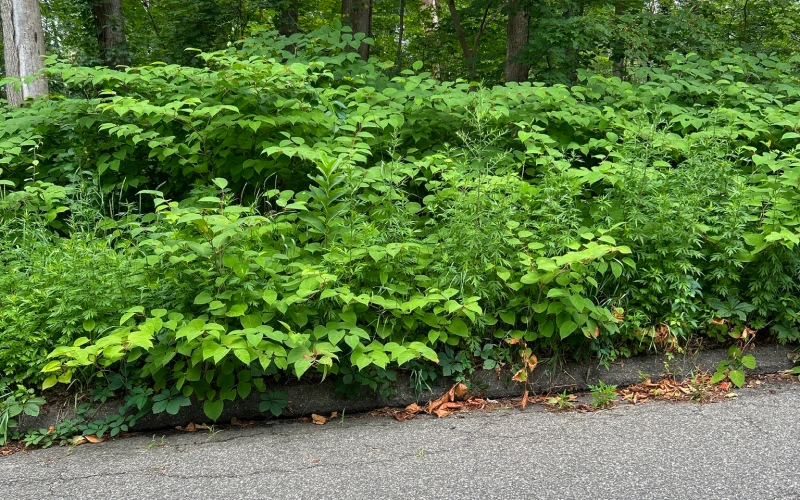Japanese Knotweed
Description
Knotweeds, including Himalayan and Japanese Knotweed, are invasive perennials that were introduced to British Columbia and other parts of North America from eastern Asia for their rapid growth and ornamental qualities. These species have since become established across the country, adversely affecting riparian areas and man-made structures with their aggressive growth. Knotweeds can grow through concrete and asphalt, causing significant damage to infrastructure[1].

© thoscarter via iNaturalist.org, used under CC BY NC
Habitat
Knotweeds prefer moist soil and can thrive in full or partial sun. They are commonly found in riparian zones, along roadsides, railways, and in gardens. These plants are especially problematic in areas with disturbed soils where they can quickly establish and outcompete native vegetation [2].
Identifying Features
| Feature | Japanese Knotweed | Himalayan Knotweed |
|---|---|---|
| Plant Size | 1.5 to 3 m tall | 2 to 3 m tall |
| Leaf Size (L/W) | 10 to 17 cm, 2/3 as wide | 10 to 20 cm, 1/2 as wide |
| Reproduction | Female/Perfect (rare) | Perfect and fertile |
| Flower Colour | Green-white to cream-white | Pinkish-white to pink |
| Flower Arrangement | Loose, drooping | Loose, spreading |
Impacts
Knotweeds:
Management and Control
Prevention is crucial for managing the spread of knotweeds. It is recommended to:
What You Can Do
For more information on identifying and managing invasive knotweeds and protecting your local ecosystems, please visit the following resources:
1. Fennell, Mark & Wade, Max & Bacon, Karen. (2018). Japanese knotweed (Fallopia japonica): An analysis of capacity to cause structural damage (compared to other plants) and typical rhizome extension. PeerJ. 6. e5246. 10.7717/peerj.5246.
2. Jacob N. Barney, Nishanth Tharayil, Antonio DiTommaso, and Prasanta C. Bhowmik. 2006. The Biology of Invasive Alien Plants in Canada. 5. Polygonum cuspidatum Sieb. & Zucc. [= Fallopia japonica (Houtt.) Ronse Decr.]. Canadian Journal of Plant Science. 86(3): 887-906. https://doi.org/10.4141/P05-170